In ancient times, people believed that birthmarks on a baby were signs of fate and predicted his future. Now scientists are considering more natural reasons for the appearance of such formations. Let's consider what factors influence the appearance of spots, and in what cases do they require removal? Why might a birthmark appear in a newborn?
Types of birthmarks
A child may have a wide variety of birthmarks on his body - smooth or covered with fluff, reddish or brown, convex or flat. The main types of birthmarks in newborns are nevi and angiomas.
What shade can nevi be?
Nevi are among the most common types of skin marks. They usually come in a variety of brownish shades, ranging from dark brown to pale. The basis of nevi are melantocytes. These epidermal cells contain melanin, a pigment that affects skin tone. It is necessary to protect the skin from ultraviolet radiation. Sometimes these cells are localized in one place, which leads to the appearance of a mole. Dark birthmarks indicate an abundance of melanin, while light ones indicate a lack of it.
A Mongolian spot in a newborn should also not be a cause for concern for parents. It is also a place of concentration of melanin and is a spot, or several spots of different sizes from 1 to 10 cm in diameter, blue, green or even black. The most common location is the baby’s lower back, mainly the tailbone or butt. Mongolian spots are safe, they do not cause any discomfort to the child and go away on their own before adolescence. This type of nevus is named so because of their frequent detection in Mongolian children (90%), Mongolian spots are also often found in Asians, representatives of the Mongoloid and Negroid races.
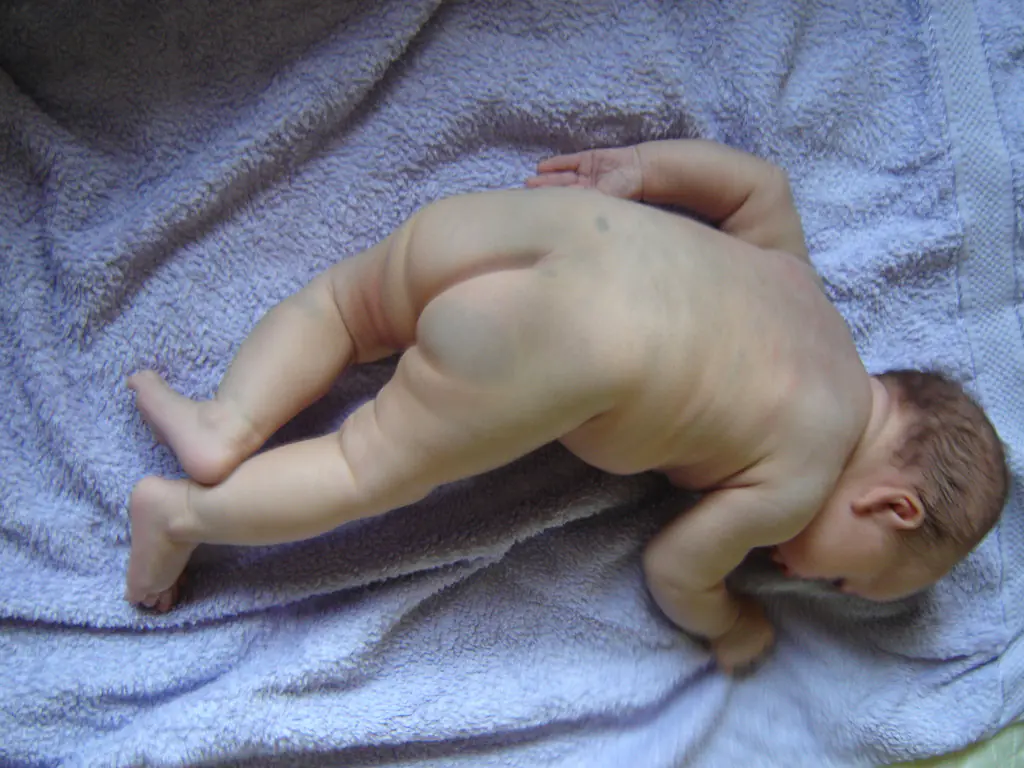
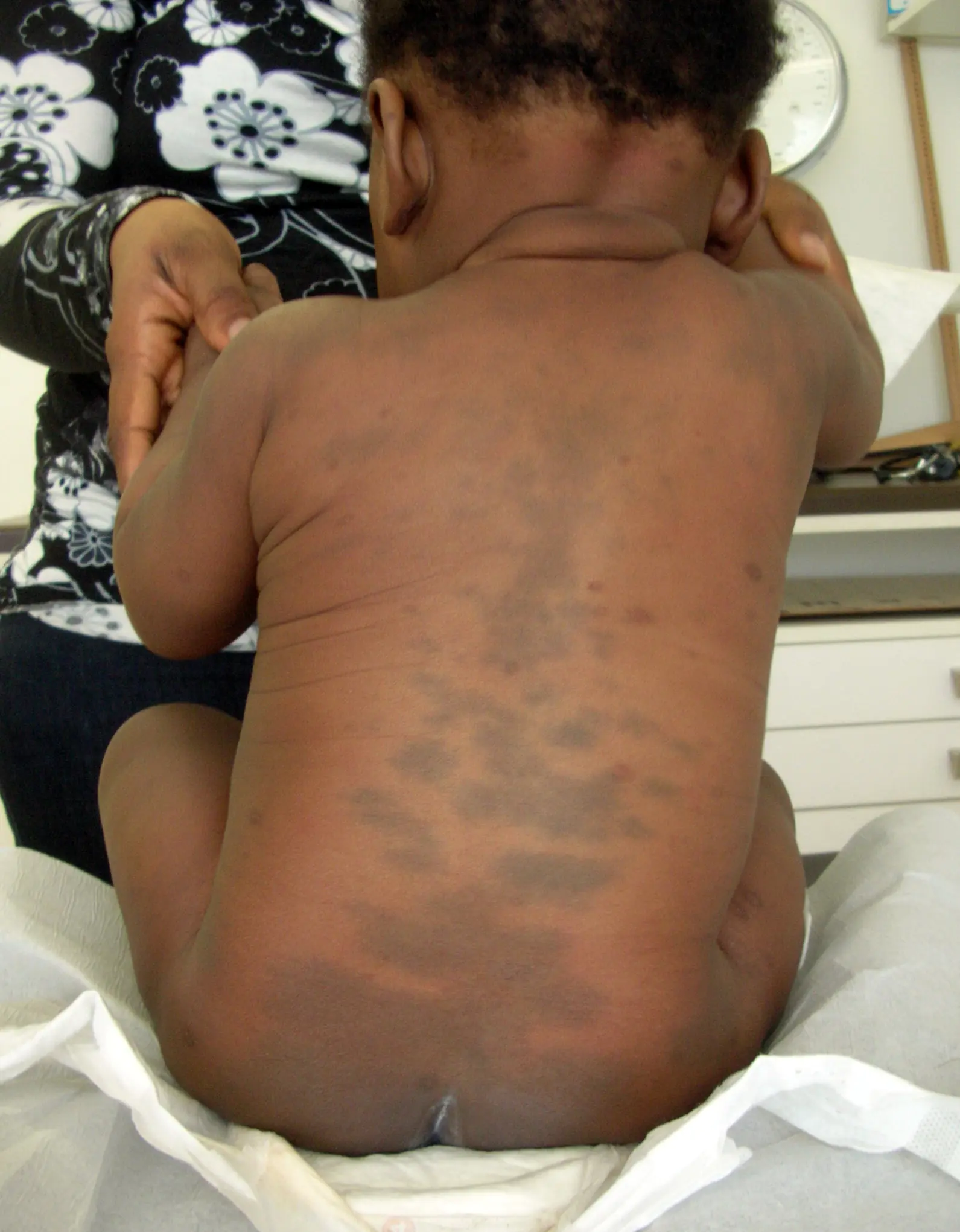
There are also white formations. These include anemic nevi that arise due to underdeveloped blood vessels.
They need to be distinguished from millet grasses - milia. The latter look like convex dots filled with whitish content. They are a type of skin rash. Anemic nevi are a congenital phenomenon, and they are easy to identify: you need to rub the spot. The surrounding skin will turn red, but the formation will remain white.
Light brown Jadassohn nevi indicate a congenital defect of the sebaceous glands. They are usually found on the baby's head, under the hairs. This occurs in 3 out of 1000 babies. It is recommended to remove it before adolescence, since in 10-15% of cases, they can subsequently develop into a cancerous tumor.
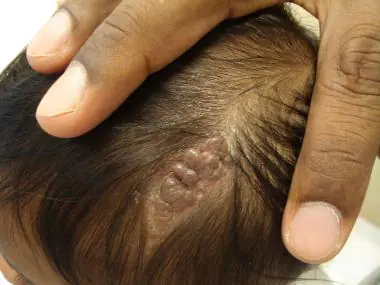
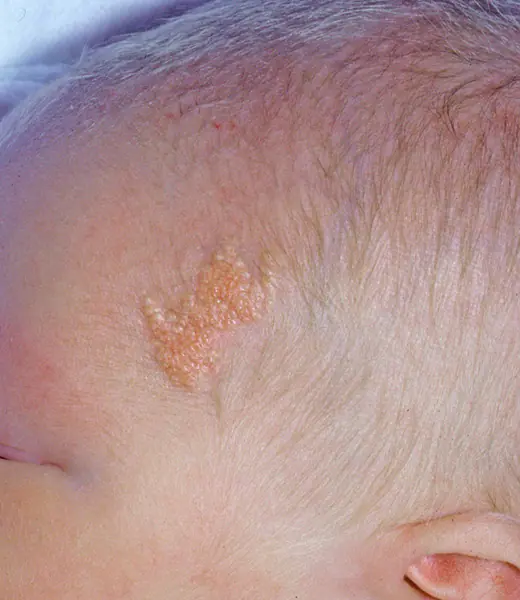
What if it’s a matter of blood vessels?
Another type of birthmarks is angiomas. They are of vascular nature. Congenital formations of small vessels on the skin are called hemangiomas. If such accumulations form in the lymphatic system, then they are classified as lymphangiomas. Even congenital, they appear externally only by the age of three.
In a newborn, only vascular hemangiomas can be detected. They are distinguished by a whole range of shades of red. Such formations are divided into several subtypes:
Strawberry (strawberry) hemangioma
These formations are convex, similar to red “berries”. They appear immediately after birth, usually on the face. The sizes can be different - from a millimeter to several in width. Strawberry hemangioma can increase in size, which is why it is dangerous, as it can affect the healthy tissues of the child.
Often this type of hemangioma stops growing, gradually brightens, shrinks and disappears completely by the age of 10.
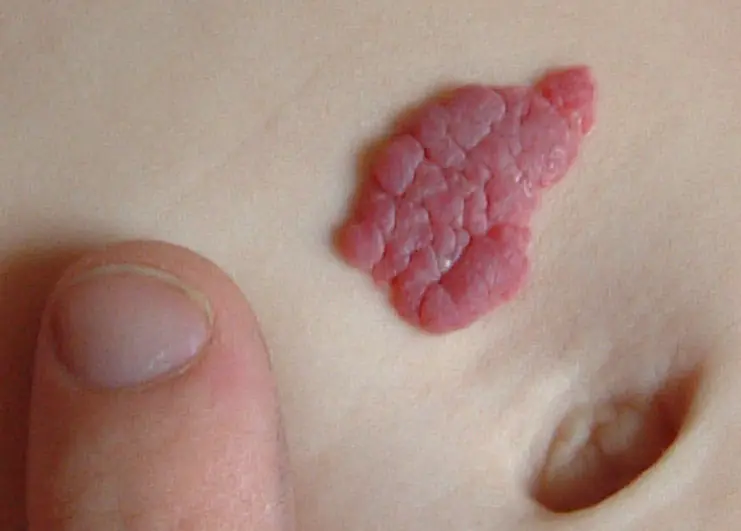
Stellate (spider) angioma
It looks like a star with a bright base and “rays” extending from it. Most often it occurs on the child's neck. Disappears on its own in the first years of life.
Cavernous hemangioma
Loose, purple hemangioma, deeply embedded in the skin. It feels warmer to the touch than the surrounding epidermis. If you press, the baby will cry due to unpleasant sensations. This type of neoplasm requires treatment.
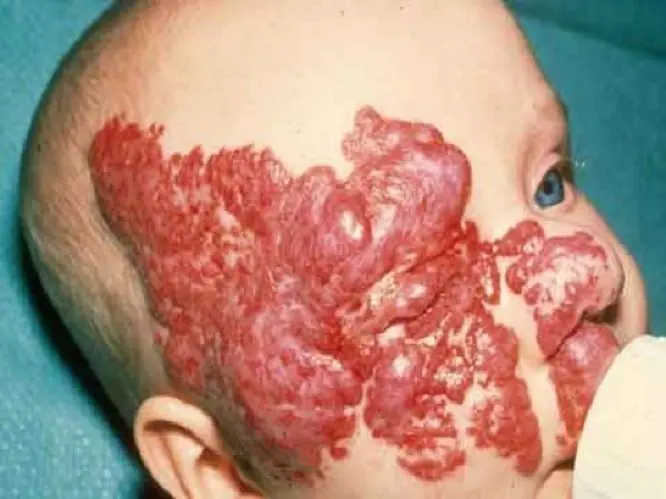
Flaming (fiery) nevus
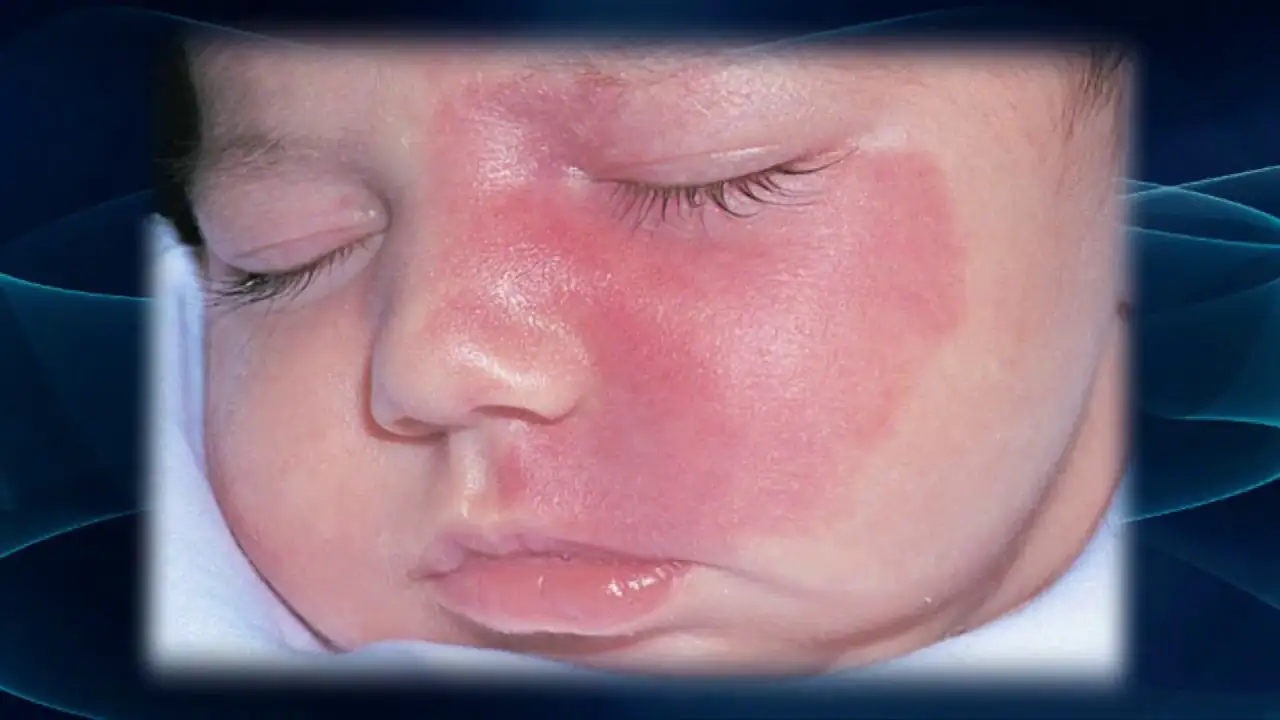
Looks like a red or purple stain from spilled wine. It can appear anywhere on the baby’s body. Such formations do not go away on their own. If they are not removed, they will remain for life. If the “wine stain” is in a visible place or continues to grow, it is better to take the trouble to correct the defect.
“Stork marks” (capillary hemangioma)
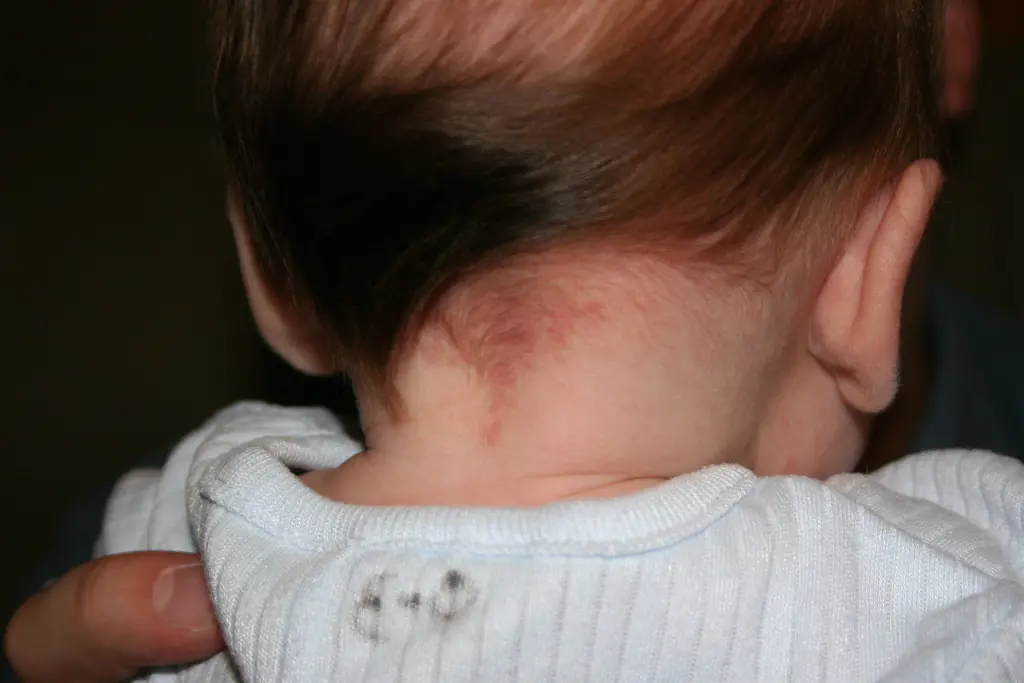
Such marks are also called “stork bites.” And if there is a mark on the baby’s forehead - “an angel’s kiss.” The formation is usually pink or red, but can also be orange, and resembles the mark of a bird's beak, which is how it gets its name. The formation is flat and does not rise above the skin. It is often found on the back of the baby’s head, in the neck area. When stressed, for example, when a baby cries, it acquires a brighter color. By the age of two, “stork marks” in most cases go away on their own.
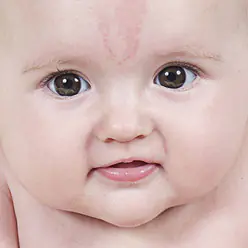
In addition to the above, there are other types of birthmarks. But they are much less common.
If you notice that a child’s hemangioma is increasing in size, immediately contact a specialist (surgeon). He will be able to assess the danger of the condition and prescribe appropriate treatment or removal of the tumor.
Causes of skin formations

The reasons for a birthmark in a newborn, of course, are not that his mother loved to pet dogs and cats, as the ancients believed. However, scientists cannot say exactly why such marks may appear. Only risk factors for their occurrence have been identified.
Why do birthmarks appear in newborns? This is affected by:
- Hereditary factor;
- Hormonal surges in the expectant mother;
- Exposure to toxic substances on the body of a pregnant woman;
- Bad ecology;
- Climate change;
- Infections of the genitourinary system.
But it happens that a birthmark appears in a newborn even without exposure to risk factors.
Birthmark on a baby: what to do?
Is your baby's birthmark small, smooth, does not grow and does not cause concern to the baby? Everything is fine, nothing to worry about. But you need to take the new growth seriously. Observe the nevus and notice whether the mark grows or hurts. If changes occur, you should visit a pediatrician or pediatric dermatologist.
If a newborn has a birthmark on his body, several rules should be followed:
- Keep this area away from direct sunlight.
- Make sure that the baby does not scratch the area with the mark.
- Try to ensure that the nevus is never exposed to caustic substances, such as household chemicals.
In rare cases, marks on the skin can be fatal. Where can it appear? Under the influence of negative factors, a simple mole degenerates into a malignant formation - melanoma. Therefore, if the spot increases in size, you should urgently contact a specialist. If the formation is removed in time, there will be no health consequences.
Should moles be removed from babies?

It is recommended to eliminate formations in infants only if there is a danger to life. In babies, the immune system is not yet very developed, and any intervention can lead to serious consequences.
In what cases do doctors recommend surgery at an early age:
- The birthmark is very large;
- The formation rapidly increases in size;
- There are more than five marks, and they are concentrated in one place;
- The mole is located in a traumatic place (under the armpits, on the belt, on the skin of the eyelid, in the anus);
- Nevus interferes with the normal functioning of organs (on the hand, in the nose, in the eyes).
Particular importance should be given to those cases if a mole transforms - changes color or shape, grows, hairs fall out of it, it begins to bleed or itch.
How to get rid of formations?

The doctor may recommend one of the methods for removing nevi, depending on the size and condition of the formation, as well as the health of the baby:
Use of pharmaceuticals
Special medications are injected into the mole tissue to promote the death of overgrown cells. No anesthesia is required, but is not suitable in case of allergy to the active substances of the drug.
Using a laser
Excision of pathological tissues with a laser beam. It is quick and painless, but the procedure is not always possible for hard-to-reach areas.
Cryotherapy
Exposure of the mole to low temperatures. Suitable for eliminating small nevi.
Surgery
Removal of the formation using surgical instruments. It is used in cases where other methods cannot be used.
Carrying out the intervention under the supervision of a doctor, with preliminary examination of the birthmark tissue, reduces the likelihood of complications to zero. After removal of large formations, scars may remain. If they are located in a visible place, when the baby grows up, you can remove the scar using cosmetic procedures.
If you believe in fate, try telling your baby's destiny using moles. But pay attention only to happy signs:
- A mark on the baby’s cheek means love;
- A spot under the hair means high intelligence;
- Moles on the hands - to talents and good luck;
- Nevi on the back - to a life without worries;
- Mark on the leg - to hard work, calmness, confidence;
- A “sign” on the butt means success with the opposite sex.
As you can see, a mole is not a reason to panic at all. With the right approach, it will not be the cause of illness, but a happy sign that emphasizes the individuality of your son or daughter.
Remember that only a doctor can make a correct diagnosis; do not self-medicate without consultation and diagnosis by a qualified doctor.
By nature, birthmarks in children are not capable of harming a small organism. The appearance of pigment formation occurs after birth or after 10–15 weeks. Moles in newborns do not indicate the presence of a disease or pathology of the body. Nevus in infants is most often located on the back of the head, on the forehead, on the stomach.
Causes of birthmarks in newborns
The reasons for the appearance of birthmarks in a newborn should be considered:
- Hereditary factor. If a man or woman has a birthmark on the face or foot, there is a high probability that the child will be born with a similar location of the pigmented formation.
- Stress during childbearing. With nervous excitement, a drop in blood pressure occurs, as a result of which the blood vessels narrow and placental blood exchange is disrupted. Bursted blood vessels transform into a red birthmark in a newborn.
- Prolonged exposure to the sun. In babies born in the summer, the number of moles may increase or the existing formations will become darker in color.
- Changes in the hormonal background of a child are one of the reasons for the appearance of a mole in a newborn.
Medical statistics indicate that girls, premature and fair-skinned children are susceptible to the appearance of brown nevi after birth.
Types of nevi
A birthmark appears in a newborn at birth or within two months after birth. There are the following types of moles:
- Vascular formation - a large number of vessels, which are presented in the form of a convex or flat nevus. The color of the vascular spot is bright red or light pink. It is recommended to remove benign formations of this type, because after a while they increase in size and cause discomfort. The child is embarrassed about his appearance if the vascular nevus is located on the face.
- A simple mole has a smooth surface and is light brown or black in color. Appear after birth or in the first twelve months of life. The appearance of a simple nevus should not worry the parents of the baby, provided that the mole does not change shape, structure and color. If the nevus is located in a place that is subject to constant injury, doctors recommend removing it.
Vascular formations are divided into the following types:
- A flaming mole or port-wine stain appears on the baby's scalp or face. The shape of such a spot is flat, the color is red. As the child grows, the size of the nevus also increases. It is not recommended to resort to removal of the formation, as it can be treated, which is based on the effect of a laser beam or infrared radiation.
- Hemangioma. It is not immediately detected on the baby’s body. After three to four months it will begin to manifest itself. Hemangiomas appear in various parts of the body and increase sharply. Medical statistics say that upon reaching the age of ten, the hemangioma will disappear, so there is no need to remove it when detected.
- The stork's bite is located on the back of the head, eyelid, and bridge of the nose. This type of nevus is pink in color. There are situations when many spots accumulate in one place.
Among the simple formations there are:
- A red nevus appears at birth or within three years and can be located in any area. Red nevi do not need treatment or removal unless there is a rapid increase in size.
- The hanging formation is benign. Because a hanging nevus involves epithelial cells, the appearance is similar to a growth. The color varies from flesh to dark brown. There are hanging moles in the armpits and groin. The presence of growths is dangerous for a child, so it is necessary to regularly visit a dermatologist for examination and examination, during which the absence or presence of cancer cells will be determined.
- The anemic spot is small in size and forms on the back or face. Vascular underdevelopment can provoke the appearance of an anemic spot. It is necessary to remove the formation using a surgical method.
- The flat blue nevus is large in size. Divided into simple and cellular. The color of the simple varies from blue to dark blue, the diameter does not exceed one centimeter, and has a smooth surface. Cellular nevus is malignant, exceeds three centimeters in diameter, and the surface is covered with nodules. Localization – buttocks, feet, hands. Removing blue spots is dangerous to health.
- The brown spot has a flat structure and can disappear on its own after five to six years. They do not pose a danger to the child's body.
- The Mongolian spot, which is located on the buttocks and thighs, is characteristic of a child with Asian roots. It is not dangerous and disappears two years after birth.
- Red spots appear on the baby's head. After the child turns one year old, the red spot will disappear without surgery or therapy.
- Strawberry hemangioma. Occurrence is rare. It has a soft structure and bright color. If the formation appeared at birth, after two years it will disappear on its own or change color to light.
When moles are dangerous
When moles appear in a newborn, it is necessary to pay attention and regularly visit a dermatologist. The doctor will use a dermatoscope to examine the formation, determine its nature and the presence of cancer cells. When bathing or changing your baby, you should carefully examine new spots or changes in existing ones. Birthmarks in a baby are not dangerous if there are no alarming symptoms. These signs include: intense increase in size and change in color, localized on the face, clear boundaries have disappeared, blood or clear liquid is released. It is necessary to visit the office of a pediatric dermatologist if the nevus in the area that is swollen and irritated is covered with hair. A cause for concern is the appearance of a bumpy surface or compaction that begins to peel off.
After the examination, the dermatologist will determine the period during which parents need to monitor the spot. If the situation worsens, the doctor will prescribe surgery to remove the nevus to avoid degeneration into a malignant formation. It is allowed to remove the growth after two years if there is no need to get rid of the stain.
When is treatment required?
If a brown nevus appears in a newborn, there is no need to worry and conduct a comprehensive medical examination. It is necessary to monitor the size, shape, and surface of the birthmark. In the absence of intense enlargement, redness or darkening, or bleeding, it is not advisable to remove the spot. If there have been cases of melanoma along the family line, parents must observe:
- Avoid mechanical damage to the nevus.
- Regularly visit a pediatrician, who will examine the formation independently or refer you to an appointment with a pediatric dermatologist.
- Minimize the baby's exposure to direct sunlight. When visiting the beach, apply protective creams to the child’s skin and put a hat on the head.
If a newborn's birthmark rubs, rubs, or the child accidentally tears it off with his hand, the formation must be removed. Without surgical intervention, the risk of the spot transforming into a malignant tumor increases. Hanging moles, which become inflamed more often than others, must be removed. When scheduling removal, parents follow the dermatologist's instructions.
Medicine offers several safe ways to remove growths on a child’s skin:
- Laser removal. The procedure is performed under general or local anesthesia. The choice of anesthesia depends on the size of the spot.
- The cryodestruction method is indicated for older children, as the procedure is painful.
- Removal with a scalpel. A surgical method for excision of large formations, hemangiomas. The operation requires general anesthesia.
The development of melanoma in infants is a rare occurrence, but visiting a doctor should not be neglected. This helps control the development of nevus and detect malignant cells.
After the birth of a long-awaited baby, many parents are faced with such an unpleasant phenomenon as birthmarks in newborns. They are called nevi or hemangiomas and can be located on the skin of the face and body, as well as the baby’s scalp.
Despite the fact that such pigmented formations are quite common in babies, they cause concern for his relatives. Should I be worried or do they pose no danger to the health of the newborn?
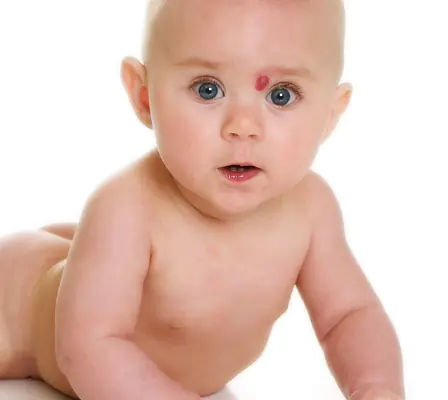
What is a birthmark?
When pigmented formations appear, the significance in a newborn depends on their shape, type and location. In most cases, infants have nevi and hemangiomas, which are formations on the skin that appear due to increased production of the coloring pigment melonin or the accumulation of blood vessels.
Nevi and hemangiomas have different shapes and sizes; most often they form in the baby during prenatal development. New growths on the skin can be flat, convex, smooth, dark or light. The photo can be seen below.
Melanocytes, special cells of the dermis containing the coloring pigment melanin, are responsible for the color saturation of nevi. The more melanin they contain, the darker the color of the tumor.
Main risk group:
- a girl is more likely to develop hemangioma than a boy;
- premature babies;
- babies with fair skin type.
Doctors believe that such babies have a higher risk of developing skin nevi and hemangiomas than other children.
Causes of stains
The reasons for the appearance of pigmented formations in newborns are most often associated with excessive accumulation of melanin, damage to the blood veins, vessels and capillaries. The final mechanism of formation of nevi and hemangiomas in infants has not been established.
The following provoking factors are identified:
- Hormonal imbalances in the mother's body.
- Fetal hypoxia during pregnancy or at the time of birth.
- The baby is born prematurely.
- Multiple pregnancy.
- Infectious diseases in the mother during pregnancy.
A birthmark in a newborn usually does not cause him any concern; it does not itch, does not itch and only requires constant monitoring. They are considered benign and the risk of their degeneration into malignant is minimal; they disappear on their own upon reaching 9-10 years of age.
Types of birthmarks
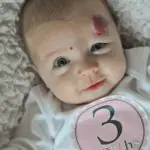

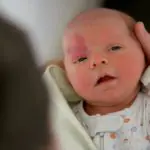
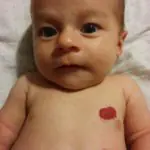
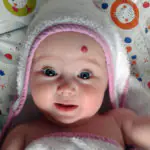
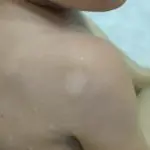
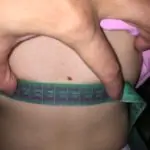
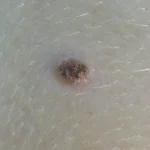
All pigmented neoplasms on the face or body of a child are divided into 2 main groups - hemangiomas and nevi. In the first case, we are talking about the accumulation of blood capillaries, which give the spot a reddish tint. Nevi are formed on the basis of melanin, so they can have a different color - from light golden to black.
Hemangiomas are divided into types:
- flat - considered the most common, characterized by a regular shape and smooth edges;
- star-shaped - they look like red dots with capillaries coming from them, disappear on their own after 1.5-2 years;
- capillary - look like wine-colored spots located in the deep layers of the epidermis;
- cavernous - when palpating such a formation, you can feel the pulsation of blood;
- strawberry (berry) - characterized by a bright scarlet hue and deformed edges.
A birthmark on the head or body of a child does not require special treatment and does not cause discomfort for the newborn. Damage or tearing off of a formation, as well as a sudden change in its structure, shape or size in newborns on the forehead, is considered a cause for alarm. In such cases, you should never hesitate to visit a doctor.
White birthmarks
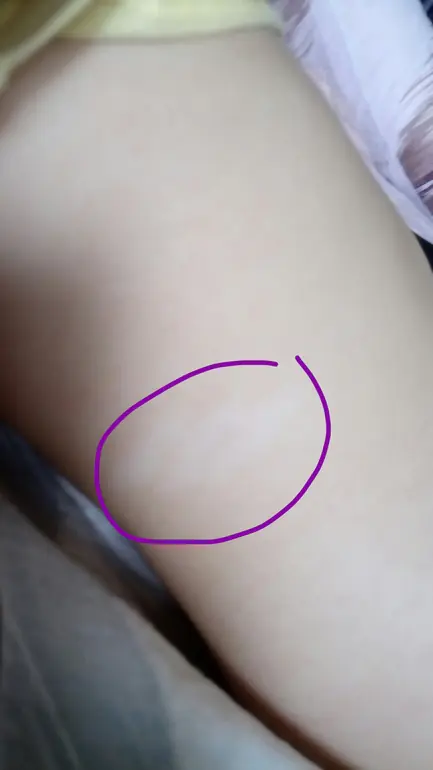
There is a separate type - white birthmarks, which are also called anemic. They do not pose a health hazard, do not tend to increase in size, but they do not look aesthetically pleasing and rarely disappear on their own.
In most cases, a white birthmark in a child is formed due to insufficient production of melanin by epidermal cells. It can have different shapes and sizes.
The main reasons for the appearance:
- Vitiligo is a common dermatological disease.
- Prolonged exposure of the child to direct sunlight.
- Heredity.
- Disorders of melanin synthesis during intrauterine development.
- Metabolism failures.
- Deficiency of vitamins and microelements in the layers of the epidermis.
Most often, white pigmented formations are localized in the area of the knees, palms, back, and fingers. When you press on such spots, the skin around them turns pink or red, but they do not change their pale shade.
White neoplasms are completely safe for a child. But parents should be careful to ensure that the newborn does not scratch or tear it off.
Birthmark in hair
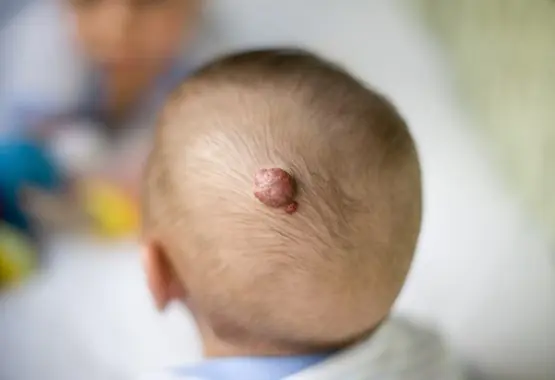
A birthmark on the scalp, also called Jadassohn's seborrheic nevus, most often occurs as a result of damage to the sebaceous glands. The pigment formation has a yellow or brown tint, most often located under the child’s hair, in the temples and neck.
In the area of the mole, the baby's hair falls out and does not grow. Jadassohn's seborrheic disease has a tendency to degenerate into an oncological neoplasm, so doctors recommend removing such formations.
Should hemangiomas be treated?

Many pediatricians and dermatologists believe that pigmented tumors are absolutely harmless to the health of the child. Their appearance is not accompanied by itching, burning, pain or other unpleasant sensations.
But parents should carefully monitor such swelling. The child should not be exposed to direct sunlight for a long time and should not scratch or injure the mole. Also, parents should not use alternative medicine to remove pigment formation on their own.
If the tumor changes in color or size, begins to crack, peel off, bleed, or is filled with liquid or purulent contents, you should definitely seek medical help to remove it.
Effective treatments:
- drug therapy - injections of drugs into the cavity of the affected area of the skin, as a result of which its cells gradually die;
- surgical intervention - surgical excision is used only for large tumors and is accompanied by pain and a long healing process;
- laser excision is one of the most popular methods for removing pigment formations in newborns, which does not cause pain and does not leave rough scars;
- radio wave method - removal of pigmented tumors is carried out using radio waves, the technology is considered highly effective and low-traumatic;
- cryodestruction - involves the use of liquid nitrogen, with which the hemangioma is frozen and dies off on its own after a few days.
Birthmarks in newborns should not cause concern to parents, since they do not pose any threat to the health and life of the baby. In most cases, pigmented neoplasms disappear on their own, without any treatment, several years after birth.
Conclusion
A cause for alarm should be a change in the affected area's appearance - shape, color, bleeding or discharge of pus. In such cases, you should immediately contact a dermatologist to remove it.



